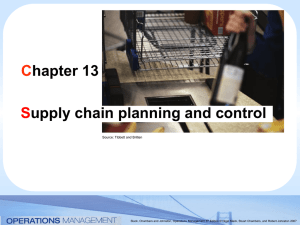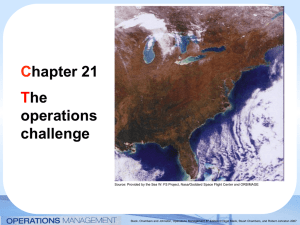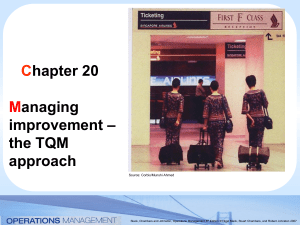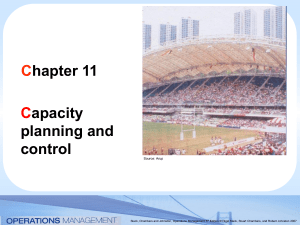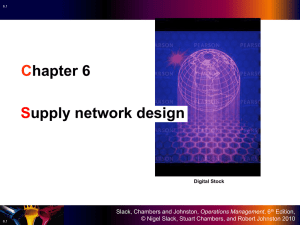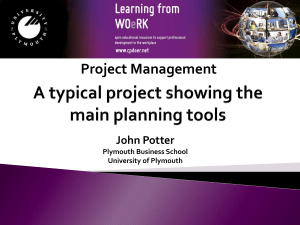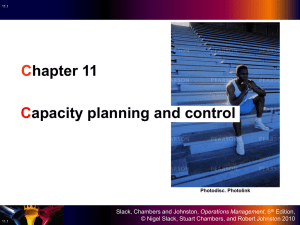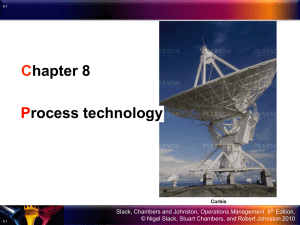PowerPoint Presentations 16
advertisement
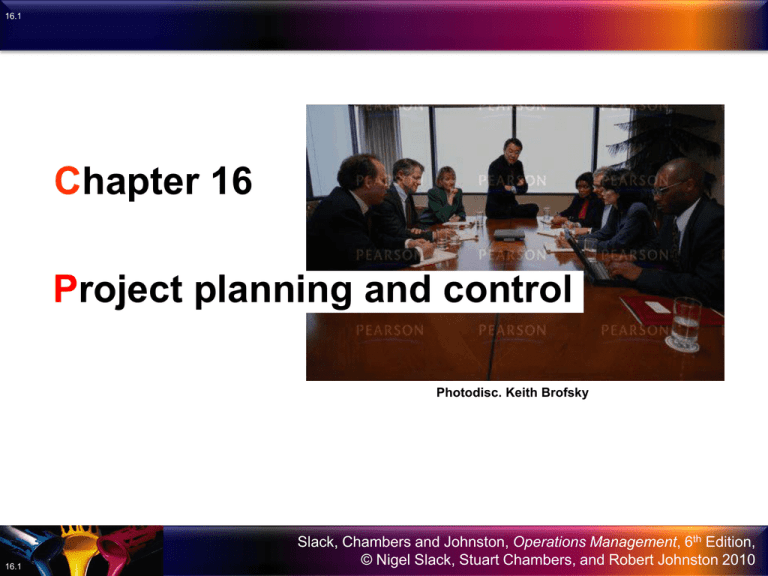
16.1 Chapter 16 Project planning and control Photodisc. Keith Brofsky 16.1 Slack, Chambers and Johnston, Operations Management, 6th Edition, © Nigel Slack, Stuart Chambers, and Robert Johnston 2010 16.2 Project planning and control Operations strategy Design Project planning and control Improvement Planning and control The market requires… specified time, quality and cost of a project The operation supplies… the delivery of the project on-time, on-specification and to budget. 16.2 Slack, Chambers and Johnston, Operations Management, 6th Edition, © Nigel Slack, Stuart Chambers, and Robert Johnston 2010 16.3 Key operations questions In Chapter 16 – Project planning and control – Slack et al. identify the following key questions: • What is a project? • What makes project management successful? • How are projects planned and controlled? • What is project planning and why is it important? • How can the techniques of network planning help project management? 16.3 Slack, Chambers and Johnston, Operations Management, 6th Edition, © Nigel Slack, Stuart Chambers, and Robert Johnston 2010 16.4 Complexity and uncertainty as project dimensions High Basic research Uncertainty Oil, gas exploration Low Antarctic expedition Military campaign Channel tunnel Airport Product development Advertising campaign Chemical plant Novel writing Individual Low 16.4 Euro project Wedding Company audit Group Organization Thames barrier Airbus Motorway Oil Tanker Multiorganization Complexity Car plants Nation Multi-nation High Slack, Chambers and Johnston, Operations Management, 6th Edition, © Nigel Slack, Stuart Chambers, and Robert Johnston 2010 16.5 Stages in project management Stage Understanding the 1 project environment Stage 2 Stage 3 Changes Project definition Project planning Corrective action Stage 4 16.5 Technical execution Stage 5 Project control Slack, Chambers and Johnston, Operations Management, 6th Edition, © Nigel Slack, Stuart Chambers, and Robert Johnston 2010 16.6 The project environment The project environment consists of all the factors that can affect the project. Econo-political environment Economy Government Geo-social environment Geography National culture The project Business environment Customers Competitors Suppliers/subcontractors 16.6 Internal environment Company strategy Resources Other projects Slack, Chambers and Johnston, Operations Management, 6th Edition, © Nigel Slack, Stuart Chambers, and Robert Johnston 2010 16.7 The stakeholder power – interest grid High Keep satisfied Manage closely Monitor Keep informed Stakeholder power Low Low 16.7 Stakeholder interest High Slack, Chambers and Johnston, Operations Management, 6th Edition, © Nigel Slack, Stuart Chambers, and Robert Johnston 2010 16.8 How projects can be defined Project strategy Project scope The project Phase 1 Phase 3 Phase 4 Phase 2 Project objectives Milestones 16.8 Slack, Chambers and Johnston, Operations Management, 6th Edition, © Nigel Slack, Stuart Chambers, and Robert Johnston 2010 16.9 Matrix management in projects Matrix management structures often result in staff reporting to more than one project manager as well as their own department. Full-time equivalent resource Department 1 Department 2 Department 3 Reporting relationship Project A Project B 16.9 Slack, Chambers and Johnston, Operations Management, 6th Edition, © Nigel Slack, Stuart Chambers, and Robert Johnston 2010 16.10 How projects are planned Identify activities Estimate time and resources Identify relationships and dependencies Identify schedule constraints Fix the schedule. 16.10 Slack, Chambers and Johnston, Operations Management, 6th Edition, © Nigel Slack, Stuart Chambers, and Robert Johnston 2010 16.11 The three project objectives of quality, cost and time Quality New aircraft project Music festival Fixed grant research project Cost 16.11 Time Slack, Chambers and Johnston, Operations Management, 6th Edition, © Nigel Slack, Stuart Chambers, and Robert Johnston 2010 16.12 Stages in the project planning process Adjust as necessary Identify the activities in the project 16.12 Estimate the times and resources for activities Identify the relationships and dependencies between the activities Identify time and resource schedule constraints Fix the schedule for time and resources Slack, Chambers and Johnston, Operations Management, 6th Edition, © Nigel Slack, Stuart Chambers, and Robert Johnston 2010 16.13 Work breakdown structure Serve breakfast in bed Produce glass of orange drink Obtain juice Produce boiled egg in egg cup Obtain glass Produce boiled egg Obtain egg cup Produce buttered toast Produce toast Obtain butter Arrange tray Obtain plates and cutlery Obtain tray Obtain bread Obtain egg 16.13 Obtain water Slack, Chambers and Johnston, Operations Management, 6th Edition, © Nigel Slack, Stuart Chambers, and Robert Johnston 2010 16.14 Work breakdown structure (Continued) Work breakdown structure for a project to design an information interface for a new sales knowledge management system in an insurance company. Design information interface for new sales knowledge management system Training Form and train user group 16.14 Specify sales training Installation Install systems Design initial screen interface Testing Test interface in pilot area Modify interface Slack, Chambers and Johnston, Operations Management, 6th Edition, © Nigel Slack, Stuart Chambers, and Robert Johnston 2010 ‘Making breakfast’ – do activities at earliest time 16.15 Time (mins) 0 1 2 3 4 5 6 7 8 9 Orange Bread Toast Activities requiring operator time Butter Boil water Water Bed room Boil egg Staff required Tray 4 3 2 1 0 0 1 2 3 4 5 6 7 8 9 Time (mins) 16.15 Slack, Chambers and Johnston, Operations Management, 6th Edition, © Nigel Slack, Stuart Chambers, and Robert Johnston 2010 ‘Making breakfast’ – minimising staff requirements 16.16 Time (mins) 0 1 2 3 4 5 6 7 8 9 Orange Bread Toast Activities requiring operator time Butter Boil water Water Bed room Boil egg Staff required Tray 4 3 2 1 0 0 1 2 3 4 5 6 7 8 9 Time (mins) 16.16 Slack, Chambers and Johnston, Operations Management, 6th Edition, © Nigel Slack, Stuart Chambers, and Robert Johnston 2010 16.17 ‘Making breakfast’ – minimising staff requirements (Continued) Time (mins) 0 1 2 3 4 5 6 7 8 9 Orange Bread Toast Boil water Water Butter Bed room Boil egg Staff required Tray 4 Activities requiring operator time 3 2 1 0 0 1 2 3 4 5 6 7 8 9 Time (mins) 16.17 Slack, Chambers and Johnston, Operations Management, 6th Edition, © Nigel Slack, Stuart Chambers, and Robert Johnston 2010 16.18 Gantt charts A Gantt chart for the project to design an information interface for a new sales knowledge management system in an insurance company. Activity a) Form and train user group b) Install systems c) Specify sales training d) Design initial screen interface e) Test interface in pilot area f) Modify interface 0 16.18 10 20 30 40 Time (days) 50 60 Slack, Chambers and Johnston, Operations Management, 6th Edition, © Nigel Slack, Stuart Chambers, and Robert Johnston 2010 16.19 Network planning Activities and network for a simple project. Activity a b c d e f Remove furniture 16.19 Remove furniture Prepare bedroom Paint bedroom Prepare kitchen Paint kitchen Replace furniture Immediate predecessors None a b a d c, e Activity duration (in days) 1 2 3 1 2 1 Replace furniture Slack, Chambers and Johnston, Operations Management, 6th Edition, © Nigel Slack, Stuart Chambers, and Robert Johnston 2010 16.20 Network analysis for a simple decorating project Activity reference a Activity duration 1 1 Event number 3 An event 1 a 2 b c 2 3 1 16.20 5 f 6 1 d e 1 2 4 Slack, Chambers and Johnston, Operations Management, 6th Edition, © Nigel Slack, Stuart Chambers, and Robert Johnston 2010 16.21 Network analysis for a simple decorating project (Continued) With earliest and latest event times 3 3 1 0 2 a 0 1 1 b c 2 3 1 5 6 d e 1 2 4 2 16.21 3 6 f 6 1 7 7 4 Slack, Chambers and Johnston, Operations Management, 6th Edition, © Nigel Slack, Stuart Chambers, and Robert Johnston 2010 16.22 Network planning Activity on arrow – Using ‘dummy’ activities to clarify relationships. 2 x x 2 1 1 y 3 y 16.22 Slack, Chambers and Johnston, Operations Management, 6th Edition, © Nigel Slack, Stuart Chambers, and Robert Johnston 2010 16.23 Network planning (Continued) Activity on arrow – Using ‘dummy’ activities to describe a relationship that could not be expressed any other way. 16.23 1 3 5 2 4 6 Slack, Chambers and Johnston, Operations Management, 6th Edition, © Nigel Slack, Stuart Chambers, and Robert Johnston 2010 16.24 Network planning (Continued) Activity on node (AON) network for simple decorating project. Prepare bedroom Paint bedroom Replace furniture Remove furniture Prepare kitchen 16.24 Paint kitchen Slack, Chambers and Johnston, Operations Management, 6th Edition, © Nigel Slack, Stuart Chambers, and Robert Johnston 2010 16.25 Network planning (Continued) The network diagram for a motorway project. 18 31 A D 5 0 0 B 10 7 8 H E 10 10 10 L 8 27 27 35 35 I F 9 C 1 G 3 4 19 19 3 J K 5 M 4 22 22 16.25 Slack, Chambers and Johnston, Operations Management, 6th Edition, © Nigel Slack, Stuart Chambers, and Robert Johnston 2010 16.26 Probabilistic network planning Probability Typical subjective probability distribution for an activity time estimate. 3 Optimistic time 16.26 5 6 Activity duration 13 Expected time Most likely time Pessimistic time Slack, Chambers and Johnston, Operations Management, 6th Edition, © Nigel Slack, Stuart Chambers, and Robert Johnston 2010 16.27 Network planning How projects are controlled Planned expenditure Actual expenditure CV ACWP ACWP: Actual cost of work performed BCWP: Budgeted cost of work performed Actual expenditure SV BCWS: Budgeted cost of work scheduled SV: Schedule variance CV: Cost variance Value of work completed 16.27 Slack, Chambers and Johnston, Operations Management, 6th Edition, © Nigel Slack, Stuart Chambers, and Robert Johnston 2010 16.28 Some of the elements integrated in enterprise project management systems Scenario planning Forecasting Risk management Critical activity analysis Float calculation Work order management Project planning Multi project analysis Complex resource scheduling Real-time reporting Project portal Web-based collaboration Document management E mail notification 16.28 Integration Resource levelling Resource availability Skills scheduling Communication Budgeting Cost management Earned value control Slack, Chambers and Johnston, Operations Management, 6th Edition, © Nigel Slack, Stuart Chambers, and Robert Johnston 2010
